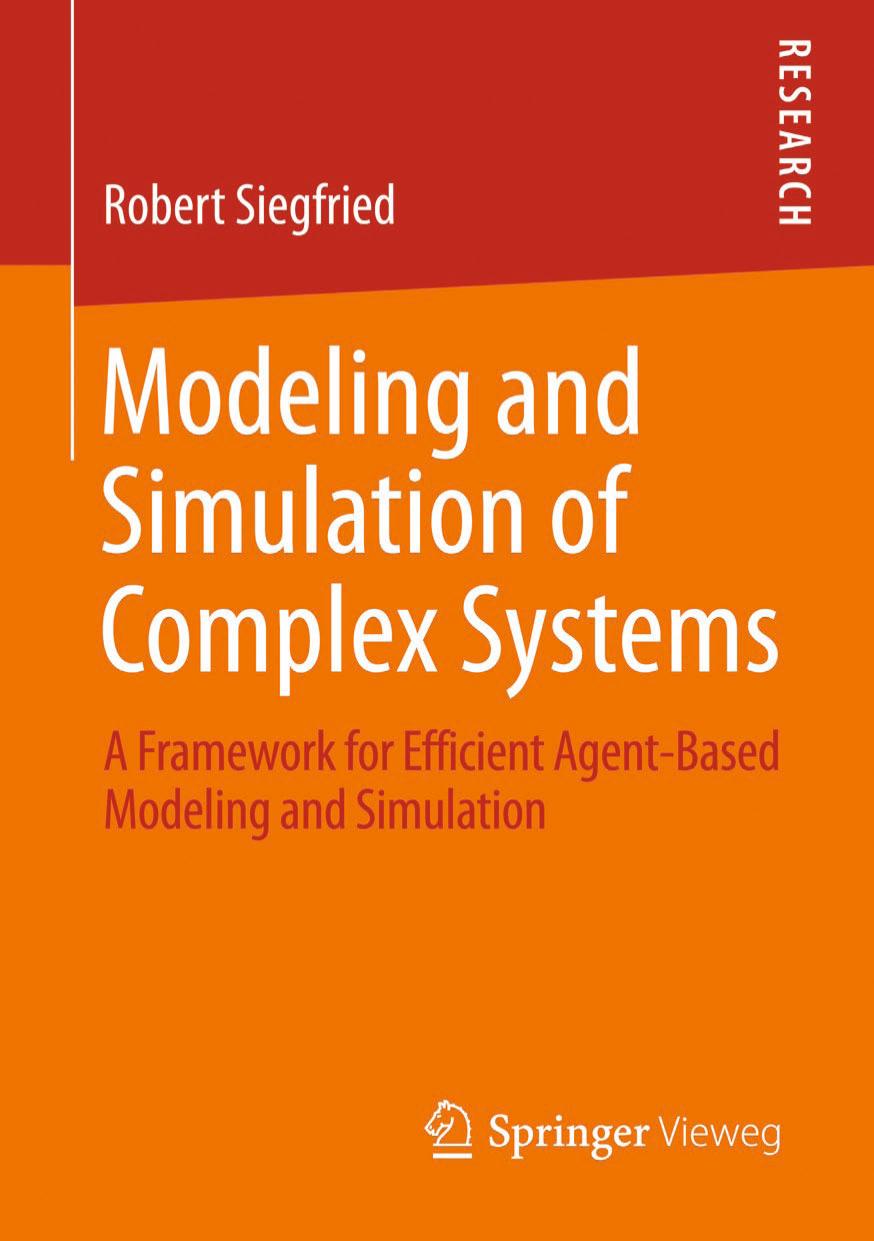Modeling and Simulation of Complex Systems 1st edition by Robert Siegfried ISBN 3658075295 9783658075293
$70.00 Original price was: $70.00.$35.00Current price is: $35.00.
Instant download Modeling and Simulation of Complex Systems after payment
Modeling and Simulation of Complex Systems 1st edition by Robert Siegfried – Ebook PDF Instant Download/Delivery: 3658075295, 9783658075293
Full download Modeling and Simulation of Complex Systems 1st edition after payment

Product details:
ISBN 10: 3658075295
ISBN 13: 9783658075293
Author: Robert Siegfried
Robert Siegfried presents a framework for efficient agent-based modeling and simulation of complex systems. He compares different approaches for describing structure and dynamics of agent-based models in detail. Based on this evaluation the author introduces the “General Reference Model for Agent-based Modeling and Simulation” (GRAMS). Furthermore he presents parallel and distributed simulation approaches for execution of agent-based models –from small scale to very large scale. The author shows how agent-based models may be executed by different simulation engines that utilize underlying hardware resources in an optimized fashion.
Modeling and Simulation of Complex Systems 1st Table of contents:
1 Introduction
1.1 Motivation
1.2 Goals of this thesis
Effective and efficient model development
Effective model execution
1.3 Approach of this thesis and outline
Part I Preliminaries and related work
2 Agent-based modeling and simulation
2.1 Basic terminology
2.1.1 Complex system
2.1.2 Model
2.1.3 Model development process
2.1.4 Simulation
2.2 Agent-based modeling and simulation
2.2.1 Agent
2.2.2 Agent architecture
2.2.3 Relationships with other modeling paradigms
2.2.4 Benefits and drawbacks of agent-based modeling and simulation
2.3 Related work
2.3.1 Klügl (2007)
2.3.2 Scheutz, Schermerhorn (2006)
2.3.3 Ferber, Müller (1996) and Weyns, Holvoet (2003)
2.3.4 DEVS and variable structure models
2.3.5 Agent-Object-Relationship Simulation
2.3.6 Further related work
2.3.7 Summary
2.4 The role of the environment in agent-based models
2.4.1 Definition and properties
2.4.2 Dynamics
3 Parallel and distributed multi-agent simulation
3.1 Basic terminology
3.2 Motivation and requirements with respect to multi-agent simulation
3.3 Existing approaches and their limitations
3.3.1 Pawlaszczyk (2009)
3.3.2 Logan, Theodoropoulos (2001)
3.3.3 P. Riley, G. Riley (2003)
3.3.4 Scheutz, Schermerhorn (2006)
3.3.5 Aaby et al. (2010)
3.3.6 Further related work
4 Summary
Part II Effective and efficient model development
5 The need for a reference model for agent-based modeling and simulation
5.1 Current problems and needs of agent-based modeling and simulation
5.1.1 Weak definitions of basic terms and concepts
5.1.2 Bad support of collaborative development
5.1.3 Need for improvement of quality by standardization
5.2 General purpose of reference models
5.3 Requirements for a reference model
5.3.1 Clear distinction between model and simulation engine
5.3.2 Simulated environment
5.3.3 Simulation time
5.3.4 Agents and objects
5.3.5 Actions, effects and constraints
5.3.6 Abstraction from specific agent architectures
5.3.7 Formal specification
6 GRAMS – General Reference Model for Agent-based Modeling and Simulation
6.1 Aims and target audience
6.2 Basic idea of the GRAMS reference model
6.3 Definition of an agent-based model
6.4 Macro-level modeling
6.4.1 Simulation time
6.4.2 Environment
6.4.3 Embedding of entities
6.5 Events
6.6 Micro-level modeling
6.6.1 Attributes of agents and objects
6.6.2 Sensors and effectors
6.6.3 State of an agent
6.6.4 Constraints
6.6.5 Behavior of an agent
6.7 Simulation of an agent-based model
6.8 Application areas of the GRAMS reference model
6.9 Evaluation
6.9.1 Mapping of basic agent architectures
6.9.2 Case studies
7 Summary
Part III Effective model execution
8 Model partitioning and multi-level parallelization
8.1 Model partitioning strategies
8.1.1 Terms and definitions
8.1.2 Conflict detection as bottleneck
8.1.3 Partitioning strategy: node-level, per agent, static
8.1.4 Partitioning strategy: node-level, per agent, dynamic
8.1.5 Partitioning strategies on cluster-level
8.2 Parallel execution
8.2.1 Parallelization on nodeand processor-level
8.2.2 Parallelization on cluster-level
8.2.3 Multi-level parallelization
8.3 Reliability of a simulation environment
9 Example implementation of GRAMS
9.1 Overview
9.2 Representation of an agent-based model
9.2.1 Simulation time
9.2.2 Environment
9.2.3 Events
9.2.4 Constraints
9.2.5 Entities
9.3 Simulation engines
9.3.1 Single-threaded event-driven simulation engine
9.3.2 Single-threaded time-stepped simulation engine
9.3.3 Parallelization on node-level
9.3.4 Parallelization on cluster-level
9.4 Test and verification
9.5 Empirical measurements
9.5.1 Simulation model used for benchmarks
9.5.2 Benchmark suite 0: Dependency between simulation time and runtime
9.5.3 Benchmark suites 1 and 2: Dependency between number of agents and runtime
9.5.4 Benchmark suite 3: Parallelization on node-level
10 Summary
Part IV Conclusions
11 Conclusions and outlook
11.1 Summary
11.2 Scientific contributions and applicability
11.3 Outlook
Part V Appendix
A Case studies of the GRAMS reference model
A.1 Case study: Warehouse
A.1.1 Structured problem description
A.1.2 Conceptual model
A.2 Case study: Joint Fire Support
Bibliography
People also search for Modeling and Simulation of Complex Systems 1st:
graph based modeling and simulation of complex systems
modeling and simulation of complex power systems
systems for modeling and simulation examples
modeling and simulation examples
modeling complex systems pdf
Tags:
Robert Siegfried,Modeling and Simulation,Complex Systems


